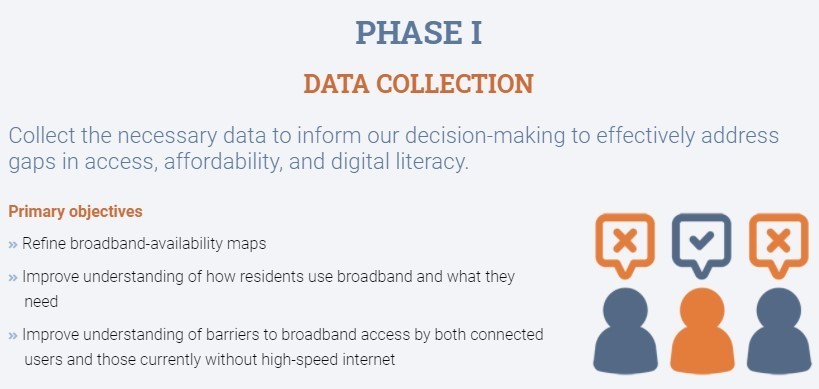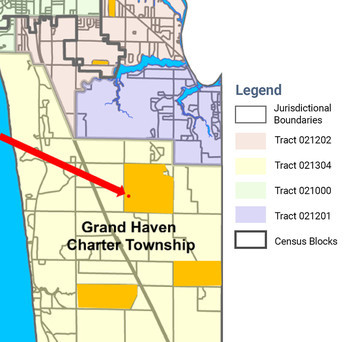Research and educational network will assist in data collection and analysis of broadband landscape
WEST OLIVE — It’s not surprising that high-speed internet has become a necessity. But in Ottawa County, broadband service remains inconsistent. Members of the public regularly report difficulties with connectivity, reliability, and affordability.
Ottawa County remains committed to tackling these persistent issues – and is partnering with Merit Network, a research and educational organization owned and run by Michigan’s public universities, to thoroughly understand the County’s broadband landscape. This vital first step is part of a larger, four-phase Comprehensive Digital Inclusion Strategy, a new initiative to ultimately establish universal access to affordable, reliable broadband across all areas of the County.
“Following a thorough interview process with multiple organizations that responded to a Request For Proposal issued by the County, it was clear Merit was the right choice to launch our Phase I effort,” said Paul Sachs, Ottawa County Planning & Performance Improvement Department director.
The County anticipates the extensive data collection process to commence as early as June 2021, with the analysis and reporting completed by the end of the year. With Merit’s collected data, the County can move on to the next three phases of its Digital Inclusion Strategy.
“Communities have been struggling with the ‘digital divide’ for decades, and while some progress has been made in closing the gap, inequities persist across the country. We are excited to partner with Ottawa County to take the next step in helping underserved (residents) achieve broadband internet success,” said Charlotte Bewersdorff, vice president of Marketing and Member Engagement for Merit Network.
To help cover the costs associated with Phase I, Ottawa County is being supported by a diverse group of partners from the local business, education, municipal, and nonprofit sectors.
“Our broadband strategy has to start with better data,” said Sachs. “The financial support from these community stakeholders has provided the boost we need to get started.”
The Data Problem
Why are Ottawa County and its partners taking the lead? Because state and federal regulators, as well as national providers, are under the mistaken impression that reliable, high-speed broadband service is consistently available in nearly all corners of the County.
The source of the data problem is inaccurate maps. The Federal Communications Commission maintains maps that illustrate broadband coverage across the U.S. based on Census blocks. But Census blocks vary widely in size based on population density. For example, a Census block in the city of Holland can be dramatically smaller than a block in a less densely populated township.
No matter the square mileage, if one home in a Census block has access, FCC maps record the entire block as having access, skewing the data. Additionally, the FCC relies upon internet providers to self-report where they have coverage. If a provider completes just one hookup in a given community, it is deemed the community is fully covered by that provider. These inaccurate maps have delayed and in some cases disqualified Ottawa County from qualifying for grants to improve service.
‘A grass-roots effort’
Ottawa County is developing a true public/private partnership to achieve its broadband goals. Post-pandemic, communities can no longer wait for federal and state governments to act.
“Taking steps now to improve broadband access will ensure all Ottawa County families and businesses have the tools to compete now and in the future,” said Sachs.
In addition to Phase I financial partners, the County is collaborating with an array of area businesses and public organizations, such as:
• OAISD, which has been involved from the project’s inception;
• Urban Wireless Solutions and KLA Laboratories, which are aiding to strategize and develop the broadband system;
• Representatives from the City of Holland Board of Public Works; Lakeshore Advantage; Spectrum Health; and community leaders and strategists
The County is also planning to share resources and methods with neighboring counties during this effort. Planning & Performance Improvement Director Sachs recently discussed these opportunities with the Allegan County Board of Commissioners.
“This Digital Inclusion Strategy is unique because it’s a grass-roots effort – we’re taking this on locally,” said Douglas Weber, president of Urban Wireless Solutions. “Ottawa County officials grew tired of simply talking about the problem and realized that it was time to take meaningful action. They have sought assistance from all corners of the community to develop a plan. Data collection is just the first step.”
New web page offers strategy insights
Concurrently with the kickoff of the Phase I data collection effort, Ottawa County has created an all-new web page that thoroughly breaks down the local broadband situation and the comprehensive Digital Inclusion Strategy.
Through a series of tabs, visitors can review past initiatives, walk through each phase of the strategy, and connect with resources. And, to increase transparency, phase updates will be posted periodically under the ‘Taking Action’ section of the Digital Inclusion Strategy tab. Explore the initiative today at miottawa.org/broadband.


